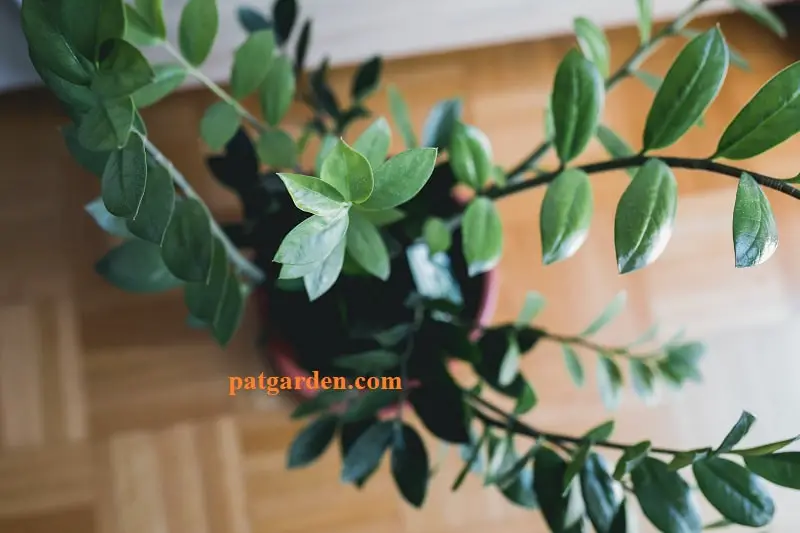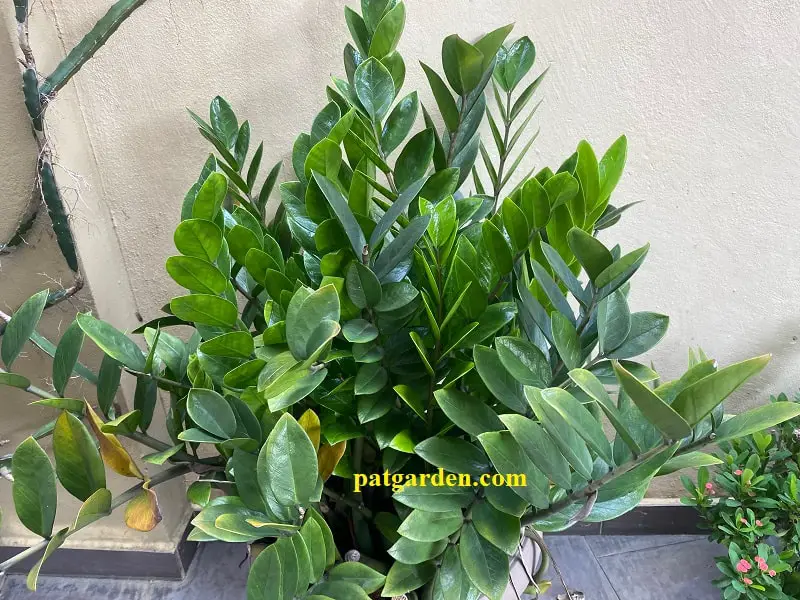ZZ plants are quite common in many homes due to their easy care requirements. It is a suitable houseplant for both novice and experienced gardeners. Browning of the leave tips is one of the major problems affecting the Zamioculcas zamiifolia plant.
This article provides detailed information about the causes and ways to fix the ZZ plant with brown tips. You will also learn how to prevent brown leave tips in ZZ plants from occurring in the future.
Why are my ZZ plant leave tips turning brown? The most common cause for the browning of leave tips in Zamioculcas zamiifolia plants is water quality, low humidity, dry soil, direct sunlight, insufficient nutrients, plant rust, and repotting shock.
If you notice your ZZ plant leave tips turning brown, the cause could be one of these potential reasons. It would be best to investigate the cause and implement the right course of action for saving the houseplant. Take the time to read through the article for deeper insights.
You May Also Like: Why Are My ZZ Plant Leaves Curling?

You May Also Enjoy: Why Does My ZZ Plant Have Yellow Leaves?
Reasons and Solutions for ZZ Plants Leave Tips Turning Brown
ZZ plants are the leading hardy houseplants in the market. It is one of the reasons behind their popularity in many homes across the country.
The indoor plant can tolerate different conditions. But this does not imply that the houseplant is immune to common problems. ZZ plants experience both yellowing and browning of leaves.
Below are the potential reasons why your ZZ plant leave tips might be browning and what you can do about it.
Quality of Water
Tap water contains salt, chlorine, Minerals, and fluoride. The buildup of these substances in the soil usually poses a serious problem to many indoor plants.
ZZ plants are quite sensitive to salt, chlorine, and fluoride. Watering this indoor plant with water direct from the tap will cause browning of the tips and the edges of the leaves.
Excess buildup of salt and minerals in the soil will scorch the leaves and turn brown in the long run. It would be best to examine the cause before taking the action.
Solutions: Stop using water from the tap since chlorine and fluoride compromise the health of your plant. Water the houseplant using either distilled water or rainwater. Another remedy is leaving the tap water overnight before using it on your plant.
Low Humidity
ZZ plants thrive in conditions with higher humidity. It enables the houseplant to produce leaves and stems with vibrant colors.
Low humidity increases the rate of transpiration. It implies that the plant is likely to lose a high amount of water when compared to the level of intake.
Failing to water the plant on time will result in wilting and even browning of the leave tips. The myth that the houseplant is drought-resistant is what makes many growers forget.
Solutions: Misting the leaves of the indoor plant regularly is recommended. It helps to increase the level of humidity to overcome the browning of leave tips. You can also place a humidifier near the plant. Avoid watering regularly since there is a high chance of overwatering the houseplant.
Direct Sunlight Exposure
ZZ plants thrive in an indoor space. The purpose is to protect the houseplant from sunburn that causes browning of the leave tips.
Bright indirect sunlight allows the plant to undertake photosynthesis without facing the scorching risk. Research shows that the houseplant cannot tolerate intense UV rays from the sun.
Failure to save the indoor plant could cause its death. The good news is that the symptoms associated with sunburns are easy to spot.
Solutions: Place the plant in a cool spot or shade. Try to water the plant according to the schedule to enable the sprouting of new leaves. Also, increase the fertilizer application routine to enable the plant to regains its vibrant colors.

Extremely Dry Soil
ZZ plants are hardy and resistant to drought. The chance of forgetting to water that plant is quite high since the plant requires less water.
We recommend sticking to the watering schedule to prevent underwatering and overwatering issues. These water stresses could result in the yellowing and browning of leaves.
Leaving the potting soil completely dry will cause drooping of leaves and wilting of the plant. Besides that, the condition is the possible cause of the browning of leave tips and edges.
Solutions: Moderate soil moisture will help to prevent the browning of leave tips. The damp soil enables the plant to get sufficient water to foster vibrant leaf colors and offer support to the plant. Always check the level of soil dryness before watering the houseplant.
You May Also Like: Why Are My ZZ Plant Stalks Falling Over?
Repotting Stress
ZZ plants have a slower growth rate. But these houseplants usually overgrow their containers after some years. It is the reason why repotting is quite important.
Replanting the indoor plant to another pot tends to pose shock and stress during the process. These conditions make the ZZ plant foliage to wilt, droop and discolor.
Never repot the ZZ plant in summer since it increases the level of browning of the leaves and wilting. It would be best to repot the houseplant in winter and consider ultimate care during the plant.
Solutions: Ensure the new container has drainage holes. Repot the plant gently to avoid shock and stress. Place the ZZ plant in the location it receives bright indirect light. Feed the plant and prune the dying leaves.
Insufficient Nutrients
Plants that are not getting sufficient nutrients usually suffer from malnutrition. ZZ plants are not heavy feeders but limiting the number of nutrients might cause browning of leave tips.
A combination of macronutrients and micronutrients make the ZZ plants grow healthy. The leaves of the houseplant will be attractive and vibrant.
Discoloration and damage leave tips are a clear indication of nutrients deficiency. Sometimes, the indoor plant tends to experience stunted growth.
Solutions: Ensure the soil is moist to facilitate the transport of nutrients from the roots. Watering and feeding your houseplant should go hand in hand. Too much water and fertilizer in the soil could lead to yellowing of leaves and other serious issues.
Pest Infestation
Pests are yet another culprit causing discoloration in ZZ plants. Some of the common insects infesting the ZZ plant are scale, spider mites, blackflies, whiteflies, thrips, aphids, and vine weevils.
These creatures are known for posing a terrible impact on ZZ plants. Insects secrete substances that facilitate mold growth. The mold inhibits the houseplant to undertake photosynthesis.
You will later notice your houseplant leaves drooping, browning, and wilting. It would be best to pay extra attention to the plant to spot these tiny creatures.
Solutions: You can manually handpick the insects or spray insecticides on the leaves. The killing of these creatures is the best option. Prune the brown leave tips to prevent the spread of the infection to other parts.
Type of Container
ZZ plants are grown in pots. There are so many types of indoor plant pots on the market. Some have drainage holes and others do not have them.
Proper caring of the ZZ plant is crucial since it prevents the occurrence of common plant issues like yellowing and browning of leaves.
ZZ plants flourish in areas that have well-drain soil. Browning of leave tips occurs as a result of soggy soil in the pot. The environment also facilitates the development of root rot that makes the plant wilt and die.
Solutions: Get a pot with drainage holes and fill it with a good mix. The role of the drainage holes is to prevent waterlogging. It is one of the best ways to save your plant from developing yellow and brown leaves.
ZZ Plant Rust
ZZ plants are highly susceptible to fungal diseases. The condition tends to affect the indoor plant in multiple ways, such as rusting.
Rusting fosters stunted growth and reduces plant vigor. The plant rust can be spread by watering and wind. Browning of leave tips is another possible sign of plant rust.
Solutions: Investigate the plant leaves to confirm if it is rust. Cut off the affected leaf to help prevent the spread of fungal disease. Spray the plant with a fungicide to prevent the disease-causing the browning leave tips.

In Conclusion
A ZZ plant is an excellent addition to your indoor space. The houseplant has a low maintenance cost, and it experiences minimal issues.
If your ZZ plant leave tips start turning brown, it could be due to fungal diseases, pests’ infestation, and dry pot soil. Fixing ZZ plant scorched leaves will help to restore its vibrant colors.
Remember to water the ZZ plant according to the schedule and provide an ideal environment that fosters proper growth.